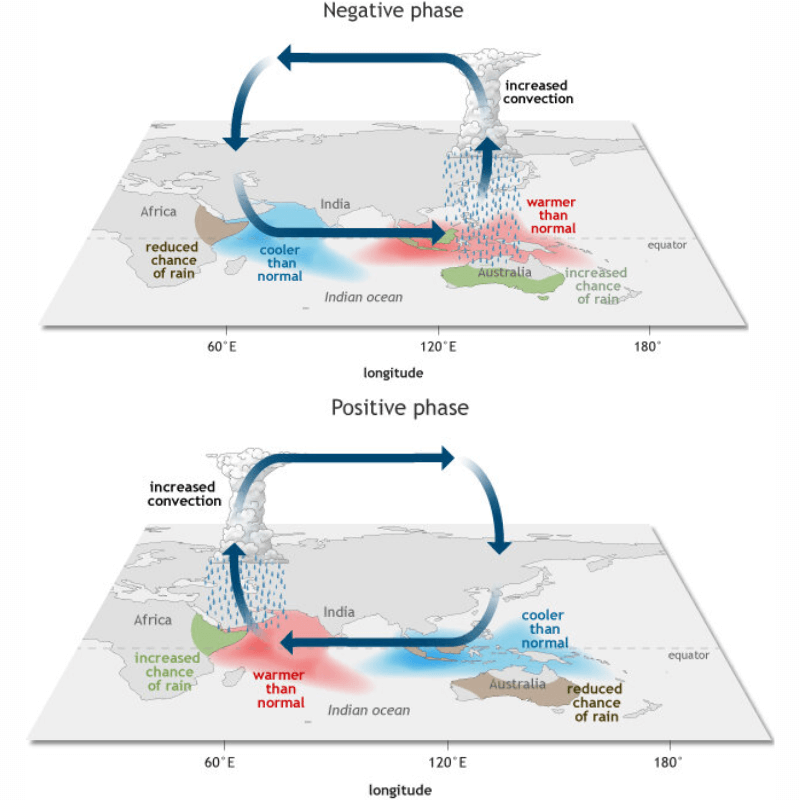
The Indian Ocean Dipole (IOD) is also known as Indian Nino or Indian Ocean’s counterpart to El Niño. The IOD affects the climate of Australia and other countries that surround the Indian Ocean Basin and is a significant contributor to rainfall variability in this region. Read here to learn in-depth about the IOD.
Recently, it has been reported that the climate models indicate a positive Indian Ocean dipole event during September-October-November.
What does the above statement mean? What is a positive IOD event? If so, what is a negative IOD even in that case? How does IOD impact the climate in the Indian Ocean basin?
Read further to get the answers.
Indian Ocean Dipole (IOD)
The Indian Ocean Dipole (IOD) is defined by the difference in sea surface temperature between two areas (or poles, hence a dipole) – a western pole in the Arabian Sea (western Indian Ocean) and an eastern pole in the east of the Indian Ocean south of Indonesia.
The IOD affects the climate of Australia and other countries that surround the Indian Ocean Basin and is a significant contributor to rainfall variability in this region.
Like El Nino Southern Oscillation (ENSO), the change in temperature gradients across the Indian Ocean results in changes in the preferred regions of rising and descending moisture and air.
In scientific terms, the IOD is a coupled ocean and atmosphere phenomenon, similar to ENSO but in the equatorial Indian Ocean.
- It is thought that the IOD has a link with ENSO events through an extension of the Walker Circulation to the west and associated Indonesian throughflow (the flow of warm tropical ocean water from the Pacific into the Indian Ocean).
- Hence, positive IOD events are often associated with El Niño and negative events with La Niña.
- When the IOD and ENSO are in phase the impacts of El Niño and La Niña events are often most extreme over Australia, while when they are out of phase the impacts of El Niño and La Niña events can be diminished.
The Indian Ocean Dipole events

Positive event:
Positive IOD events are associated with decreased rainfall in eastern Indian Ocean regions, such as Indonesia and Australia, and increased rainfall in the western Indian Ocean, including the eastern coast of Africa and the Arabian Peninsula.
- warmer sea surface temperatures in the western Indian Ocean relative to the east
- easterly wind anomalies across the Indian Ocean less cloudiness to Australia’s northwest
- less rainfall over southern Australia and the Top End.
Negative event:
Negative IOD events can result in increased rainfall and flooding in eastern Indian Ocean areas and decreased rainfall in the western Indian Ocean regions.
- cooler sea surface temperatures in the western Indian Ocean relative to the east
- winds become more westerly, bringing increased cloudiness to Australia’s northwest
- more rainfall in the Top End and southern Australia.
Impact on Weather
It can have significant impacts on regional weather patterns, including rainfall and temperature variations, particularly in the Indian subcontinent, Southeast Asia, and parts of East Africa. The IOD is often referred to as the “Indian Ocean’s counterpart to El Niño.”
- The IOD’s influence on sea surface temperatures and atmospheric pressure can have far-reaching effects on regional weather patterns.
- Positive IOD events can lead to droughts in countries like India, which rely heavily on the monsoon rains, as well as reduced agricultural productivity in affected areas.
- Conversely, negative IOD events can bring relief from drought conditions in some regions but can also lead to an increased risk of flooding.
Read: Impact of climate change on Indian monsoon
Variability and Prediction
- The Indian Ocean Dipole exhibits variability on various timescales, from intra-seasonal to interannual.
- Predicting the IOD is challenging, but advances in climate modeling and monitoring have improved the ability to forecast its development.
- The IOD is influenced by multiple factors, including ocean-atmosphere interactions and interactions with other climate phenomena like El Niño.
Past events
The positive IOD event is known to help the South-West monsoon. The 2019 event was one of the strongest on record.
- It drove the Indian monsoon to excess and extended it into October.
- For Australia, a positive IOD event year brought low rainfall from October to December, a late monsoon onset, and low tropical cyclone activity.
Indian Ocean Dipole and ENSO
Indian Ocean Dipole is a varying ocean-atmosphere system in the Indian Ocean like ENSO in the Pacific Ocean.
ENSO and IOD are not directly linked but can influence each other indirectly. For example, during El Niño, the warming of the central and eastern Pacific can affect atmospheric circulation and rainfall patterns, which, in turn, can impact the IOD by affecting the trade winds and ocean currents in the Indian Ocean.
- There are instances when a positive IOD and El Niño occur simultaneously, leading to compounded and potentially more extreme impacts on regional climate variability.
- It was observed that a positive IOD index often negated the effect of ENSO, resulting in increased Monsoon rains in several ENSO years like 1983, 1994, and 1997.
Conclusion
The Indian Ocean Dipole is a vital climate driver that can significantly impact ecosystems, agriculture, water resources, and economies in the Indian Ocean region.
It underscores the complex interactions between ocean and atmosphere and the need for improved climate prediction systems to manage the potential impacts of its positive and negative phases.
Previous year question
Q. With reference to ‘Indian Ocean Dipole (IOD)’ sometimes mentioned in the news while forecasting the Indian monsoon, which of the following statements is/are correct? (2017)
- The IOD phenomenon is characterized by a difference in sea surface temperature between the tropical Western Indian Ocean and the tropical Eastern Pacific Ocean.
- An IOD phenomenon can influence an El Nino’s impact on the monsoon.
Select the correct answer using the code given below:
(a) 1 only
(b) 2 only
(c) Both 1 and 2
(d) Neither 1 nor 2
-Article by Swathi Satish





Leave a Reply